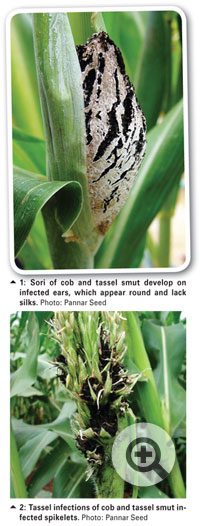April 2014
BRADLEY FLETT, ARC-Grain Crops Institute
Cob and tassel smut, also known as head smut is caused by the fungus Sphacelotheca reiliana (syn. Ustilago reiliana) and occurs in South Africa, Australia, Mexico, New Zealand, Asia and south eastern Europe.
Cob and tassel smut was a major threat to maize production in South Africa during the late 70’s and early 80’s reducing yields due to serious epidemics. Resistant maize hybrids were introduced to control these early epidemics.
In the last five to six seasons, cob and tassel smut epidemics have occurred sporadically with significant seasonal variations. Epidemics have been prominent in certain areas in Mpumalanga where the disease has resulted in major yield losses in outbreak seasons. The primary reason for these outbreaks is the introduction of susceptible hybrids and weather conditions that have been favourable for infestation of the seedling and systemic growth of the organism in the maize plant.
 Symptoms
Symptoms
Economic importance
Infection in a developing maize ear destroys the grain entirely. A 10% infection results in a 10% yield loss. Harvested grain is often so contaminated with spores that it is downgraded when delivered to the silo, resulting in further losses. Continued planting of susceptible maize hybrids and favourable conditions for disease development will result in higher initial inoculum levels which may put maize production in infested areas at risk.
Epidemiology
S. reiliana is soil borne and spores are wind-dispersed. Spores hibernate in soil and may remain viable in the soil for many years. Soil temperature is critical for infection (21°C - 28°C) of maize seedlings. Moderate to low soil moisture levels (below 50% field capacity) and acid soil conditions (pH 5,5) favours infection.
The fungus’ mycelia grow systemically behind the growth point of maize plants until sexual maturity of the crop, after which the fungus erupts in the ear and tassel tissues. These infected maize tissues develop galls and produce spores that are again released into the air to repeat the cycle.
Control measures
Resistant hybrids
Public and private breeding programmes identified useful sources of resistance and were responsible for reducing the impact of the epidemics observed during the 1970’s and the 1980’s. The disease was brought under control until recent outbreaks were observed. Selection of resistant hybrids is the most sustainable control option for this disease. Cultivar reactions for the short and long season hybrids have been screened over a number of seasons and localities. Results indicate adequate variation in susceptibility to cob and tassel smut.
Soil fertility
Soil nitrogen deficiencies result in increased incidence of cob and tassel smut. Correct fertilisation and nitrogen applications will limit infections. Liming to increase soil pH will help to reduce infections by this pathogen. Adequate plant nutrition reduces stress levels which increase the incidence of cob and tassel smut due to slow growth.
Sanitation systems
Rotation with any other crop will reduce inoculum levels in soil. Rotations must at least be away from maize for a number of seasons to be effective as the spores survive for up to seven years in soil. Burning all infected plants will reduce inoculum build-up in soil.
Planting date
Later planting, when soil temperatures have increased and rainfall is more frequent, will reduce levels of cob and tassel smut infection. This is due to plants being less stressed and vigorous seedling growth reducing cob and tassel smut infections.
Fungicides
In South Africa, fungicide seed treatments have been registered for cob and tassel smut control. The efficacy of such treatments is also dependant on prevailing soil environmental factors. Seed companies are continuously evaluating new seed treatment fungicides for efficacy to cob and tassel smut.
Quarantine
In various countries strict quarantine measures have been used with great success to reduce inoculum build-up and disease spread.
Publication: April 2014
Section: Input Overview